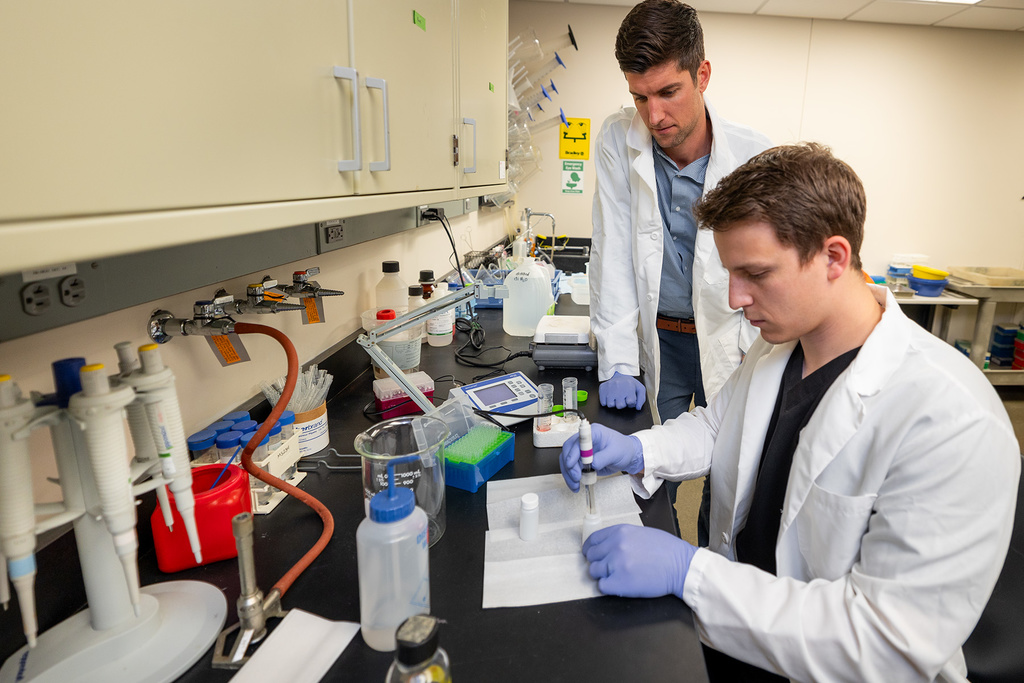“Learning how to think critically and appraise research is extremely important—nothing in dentistry is going to stay the same, and we need to be able to take what’s new, evaluate the strength of the research and apply it to practice,” said Colton Curtis, a fourth-year dental student at the University of Iowa.
The Dental Student Research Program at Iowa Dentistry has a long and venerable tradition of instilling these kinds of commitments in its students.
Curtis’ experience over the course of his dental career illustrates this well. He began doing research in his first year, but it took him a while to zero in on the right topic.
“I started doing a literature review with my first idea only to discover that it wasn’t a feasible option for a study,” Curtis explained.
That’s when he began working with Robert Bowers, assistant professor of family dentistry and they settled on a research idea.

“The problem was that older patients with a denture often have already demonstrated an increased susceptibility to tooth decay, and they also frequently experience dry mouth,” Colton said, “both of which put them at even higher risk to lose more teeth, which can significantly reduce quality of life for these older adults.”
Curtis and Bowers began to explore MI Paste, a topical product that can protect teeth from decay and promote remineralization. Their idea was for MI Paste to be applied to the underside of a person’s denture, rather than its labeled use for wiping on the teeth, so that it wouldn’t be washed away as easily via saliva, eating, or drinking, thereby sustaining release of the paste and prolonging the duration of its effect.
In the first clinical study, Curtis took baseline measurements of acidity levels and buffering capacity of patients' saliva, took out their dentures, applied the MI paste under the dentures, placed the dentures back in the patient’s mouth for 15 minutes, and then measured acidity levels and buffering capacity again. Buffering capacity is the degree to which the saliva can resist a significant increase in its acidity level after, for example, drinking an acidic beverage.
The results were promising as the intervention significantly increased the saliva's buffering capacity.
“The study showed us proof of concept—that the paste would release appropriately from under the dentures,” Curtis explained.
Curtis and Bower’s second clinical trial took this proof of concept and designed a daily intervention for patients to use. In this study, patients were asked to apply the MI Paste to the bottom side of their dentures. After wearing them, they would report the subjective assessments related to dry mouth, comfort, and so forth. This study also introduced the use of a second product, Biotene Dry Mouth Gel, to be applied in a similar fashion.
This study adds to the previous laboratory data to show that the off-label use of these products provide patients significant subjective benefits of extended duration, especially for those who suffer from dry mouth.
“This is a really awesome and interesting population to conduct research for,” Curtis said, “it is a very unique group and there is little research aimed at improving oral health care using therapeutics specifically designed for older adults wearing dentures.”
Curtis plans to continue his education in an orthodontics residency program at Virginia Commonwealth University next year.
And he intends to take the insights he’s gleaned from research into his career.
“Researching and designing a trial teach you how to make improvements, and you learn so much about evaluating other research,” Curtis explained.
Curtis credits his success in research to Bowers’ influence.
“He’s been an incredible mentor, treating me as a colleague while offering guidance and resources well beyond what I expected,” Curtis added.
